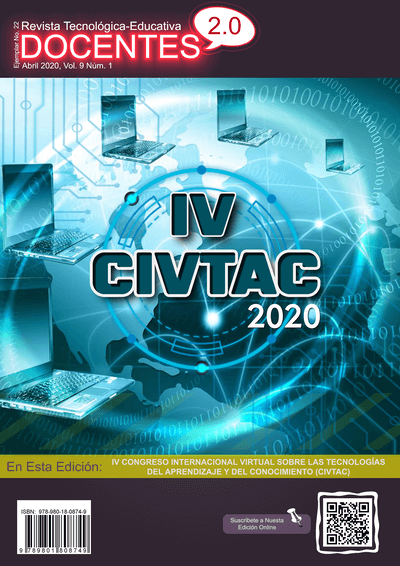Generation of the Study Program "Precision Mechatronic Design" of the Technological Institute of Hermosillo, Under the Competency-Based Curriculum Model
 DOI:
https://doi.org/10.37843/rted.v9i1.108
DOI:
https://doi.org/10.37843/rted.v9i1.108
Main Article Content
Abstract
The demand of the labor market within the industry, as well as the changing globalized market, increasingly require engineers with adaptable and changing qualities, especially in focused commercial sectors, where technical and scientific knowledge are of high importance, which make Engineer a human capital of great value for the industrial sector. At the educational level, within the Technological Institutes attached to the National Technological Institute of Mexico, teaching-learning systems that meet industrial needs are sought, so that academies work together with the government sector and the productive sector, to adapt the models education in specialties according to the needs of the regional and national commercial sector. The objective of this research is to project and elaborate the subject of “Precision mechanical design” for the Mechatronics Engineering specialty of the Technological Institute of Hermosillo, called “Mechatronic design for the aerospace and automotive industry”, based on the competency model and the previous analysis of industrial needs.
Downloads
Metrics
Article Details

This work is licensed under a Creative Commons Attribution-NonCommercial-NoDerivatives 4.0 International License.
Those authors who have publications in our journal accept the following terms:
- When a work is accepted for publication, the author retains rights of reproduction, distribution of his/her article for exploitation in all countries of the world in the format provided by our magazine and any other magnetic medium, optical, and digital.
- Authors will retain their copyright and guarantee the journal the right first to publish their work, which will be simultaneously subject to the Creative Commons Acknowledgment License (Attribution-NonCommercial-NoDerivatives 4.0 International (CC BY-NC-ND 4.0)). That allows third parties to copy and redistribute the material in any medium or format, under the following conditions: Acknowledgment - You must properly acknowledge authorship, provide a link to the license, and indicate if any changes have been made. You may do so in any reasonable way, but not in a way that suggests you have the licensor's endorsement or receive it for your use. NonCommercial - You may not use the material for a commercial purpose. NoDerivatives - If you remix, transform, or build from the material, you cannot broadcast the modified material. There are no additional restrictions - You cannot apply legal terms or technological measures that legally restrict you from doing what the license allows.
- Authors may adopt other non-exclusive license agreements to distribute the published version of the work (e.g., deposit it in an institutional archive or publish it in a monographic volume) provided that the initial publication in this journal is indicated.
- Authors are allowed and recommended to disseminate their work through the Internet (e.g., in institutional telematic archives, repositories, libraries, or their website), producing exciting exchanges and increasing the published work's citations.
- Request of withdrawal an article has to be done in writing by the author to the Editor, becoming effective after a written response from the Editor. For this purpose, the author or authors will send correspondence via e-mail: [email protected].
- The author will not receive financial compensation for the publication of his work.
- All Docentes 2.0 Journal publications are under the Open Journal System (OJS) platform at: https://ojs.docentes20.com/.
References
Becerra, A. y Vázquez, M. (2016).La industria aeroespacial en México: Situación y perspectivas. En, Bocanegra, C. y Vázquez, M. (Coords). Integración económica. Dinámica y resultados(1er edición, pp. 289-309).
Jorale Editores y Universidad de Sonora. Dirección General de Escuelas Secundarias Técnicas. (2019).Breve Historia de los Institutos Tecnológicos. Tecnológico Nacional de Méxic. http://www.dgest.gob.mx/informacion/sistema-nacional-de-educacion-superior-tecnologica.
Gamino, A. (2018).Modelo Educativo del Tecnológico Nacional de México(1st ed., p. 3). D.R. © Tecnológico Nacional de México. Instituto Tecnológico de Hermosillo. (2017).Diseño Mecánico de Precisión. http://ith.mx/documentos/reticulas/mecatronica/8/DMD-1704%20DISE%C3%91O%20MECANICO%20DE%20PRECISION.pdf.
Instituto Tecnológico de Hermosillo. (2018). Ingeniería Mecatrónica. ITH. http://ith.mx/mecatronica.html.
Instituto Tecnológico de Hermosillo. (2019). Prontuario Estadístico del Instituto Tecnológico de Hermosillo 2019-1.ITH. http://ith.mx/documentos/PRONTUARIO%20ESTADISTICO%202019-1.pdf.
Instituto Tecnológico de Hermosillo. (2020).Misión y valores.ITH. http://ith.mx/vision.htmlhttp://ith.mx/vision.html.
Ordoñez, A., Barrera, M. & Flores,C. (2018). Congreso Latinoamericano de Ingeniería y Ciencias Aplicadas, (1ª edición, pp.1111-1115. San Rafael de Mendoza: Facultad de Ciencias Aplicadas a la Industria, Universidad Nacional del Cuyo.
Palacios, J. (2020). La “megarregión arizona-sonora” como zona específica de intensa acumulación (zeia) en el espacio global para la expansión del capital transnacional de la frontera México-Estados Unidos.Revista Pós Ciências Sociais,16(32), 21. https://doi.org/10.18764/2236-9473.v16n32p21-49.
Tecnológico Nacional de México (2014). Manual de usuario para el Sistema de Registro de Especialidades SIRESP, TecNM.Tecnológico Nacional de México. (2015). Manual de Lineamientos Académico-Administrativos del Tecnológico Nacional de México. (2ª edición). TecNM.






